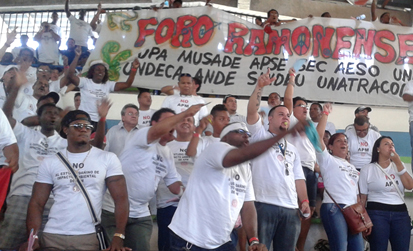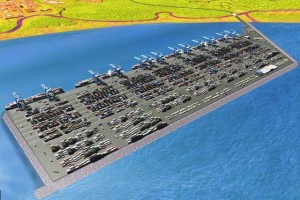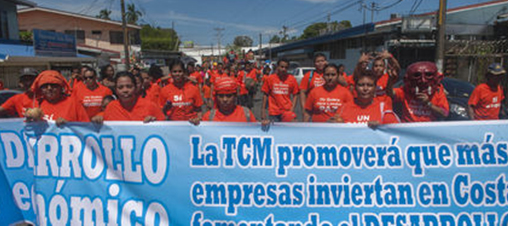Costa Rica lives today (November 11, 2013) a strong social tension in its most important port (Puerto Limon). Limon port has been closed: cruises have had to eliminate its visit to Costa Rica and cargo ships have waiting long hours funded in front of its coasts. Workers protest in the streets, and the port administration thinks the problem could be over with bringing temporary workers from Panama or Colombia, and protect facilities with the help of the local and national police.
This whole situation sabotage for the development of port activity is due to the rejection that the dockworkers’ union is against the proposal of the Dutch company APM Terminals to build a new container terminal in Moín (known by the Spanish acronym TCM).
Some participants into the public consultation on the construction of the TCM organized by SETENA (government quality control organization). (Source: Roger Rios/Limon city, Saturday November 9, 2013. Archives)
Background
The situation indicated above has at least a history of five years, which is summarized below.
During the second Government Administration of Dr. Oscar Arias Sanchez – internationally recognized political figure with Nobel Peace Prize (1987) -, was rescued the project “Limón Ciudad Puerto” (port city Limón), launched in 2004.
With the approval and delivery of the Act No. 8725 of June 10, 2009, which provides for the implementation of this project, the Port City concept became part of everyday language of Costa Ricans. This Act is based on a loan agreement with the World Bank, for eighty million of dollars, and is intended for the construction of a series of public works to improve the lives of the residents of Limon, and make more pleasant the visit of the cruise travelers.
The initiative to modernize the city was accompanied by a proposal for port development.
The government opened an international participation project to find an investor interested in building a modern container terminal, and exploit the movement of this type of load. The project was won by the Dutch company APM Terminals.
JAPDEVA is an important actor in this scene because is the Port Authority of Caribbean ports. It is a state company with fifty years of existence, it has a valuable human capital, but decades ago it stopped investing in port infrastructure and equipment specialist.
This situation of the ports of Costa Rica is exposed in the report 2012 -2013 conducted by the World Economic Forum, which analyzed 144 economies, and places this port in the positions of the ranking, No. 57 for competitiveness, and No. 140 in port infrastructure.
In the context of these data, the ports of Limon, technically known as “Limon – Moín port complex”, are an interesting phenomenon to analyze, particularly when we have only a port crane, and with this one port moves more than a million containers annually.
Draft of the new Moin Container Terminal, Costa Rica. (Source: APM Terminals)
In the above situation we add two additional factors: first, the sensitive foreign trade growth of Costa Rica derived largely from the free trade agreements that the country has established with Canada, China, Peru, Chile, and other nations; the second is regional, and the possibility of creating a Caribbean Competitive Zone between Panama and Costa Rica.
Above mentioned has led to strong growth in cargo volume and this has shown that Costa Rica can take advantage of its strategic position, with a coastline on the Caribbean and the Pacific, but exists a pressing need for better port infrastructure conditions.
The issue to be resolved
Opposition JAPDEVA workers union to the proposal for building a new container terminal in the Caribbean is based on several assumptions:
-
JAPDEVA operates today with a staff of 1800 workers and if TCM is constructed, only it will require 600 workers. The threat of unemployment in a region that already has the highest unemployment rates in the country and the lowest in terms of Human Development, creates great uncertainty for many families.
-
The new TCM will work with exclusivity in the handling of containers leaving very little cargo handling for the current ports. In the eyes of many people, particularly from Limon, this looks at the history of other public institutions as the State itself did break in the eighties of the last century; i.e. as the railroad service close.
-
Today unionists support any argument to help them to stop the construction of the TCM. So they have found an important ally in the environmentalists who question the environmental impacts that the project could generate. What irony!, Many unionists whom eat meat and turtle eggs, shout today to respect the RAMSAR Convention, which protects wetlands, and supports saving the turtles that spawn in the area designated for the construction of the TCM.
76% of the population Limon, majority, want the TCM will be constructed according to a study by the National Technical Secretariat – SETENA .
For those who favor the project, it represents the possibility of a better future for the province and the region; they aspire to growth in the number of jobs and reducing poverty. Mainly, they wish their children to grow up in a more prosperous zone, and this helps to reduce the crime rate and discourages young people to get involved in the drug trade which now hits much to this region.
Group who supports the construction of the TCM. (Source: Roger Rios/Archives)
From the point of view of the state, the construction of the TCM is an urgent need to respond to the demands of international trade, improve the country’s position in the global economy, achieve better socio-economic development, and promote the growth of port SMEs and export-related services and the maritime port sector.
The outcome
The confrontation is ready. On the part of union with paralysis of the port operation, street demonstrations, and even they threaten to reach more.
With a 76% of the population that supports TCM project, some supported groups wear orange shirts off to concentrate on the streets, albeit somewhat shy and fearful, because some union threats.
The government wants to protect the design and legal approval of the TCM, but their actions are limited by the same area of action and full respect for democracy.
APM Terminal local office wants to convince the entire population of the benefits of their project, but seem to achieve it in a half.
During the following weeks, the province of Limón and probably San Jose, the capital city of Costa Rica, will be affected in various ways by this dispute, which almost has an ending already written: Yes, a new TCM will be built.
Head Image: Puerto Moin in Limon. (Source: Roger Rios/Archives)
Puerto Limón: las luchas sociales en la definición de la ciudad portuaria
Costa Rica vive hoy (11 de noviembre del 2013) una fuerte tensión social en su puerto principal (puerto Limón); el puerto está cerrado, no se atienden cruceros ni buques de carga. Los trabajadores protestan en las calles, y la administración portuaria piensa solucionar el problema trayendo operarios temporales de Panamá o de Colombia, y resguardar las instalaciones con ayuda de la policía.
Toda esta situación de sabotaje al desarrollo de la actividad portuaria, se debe al rechazo que el sindicato de trabajadores portuarios tiene contra la propuesta de la empresa holandesa APM Terminals, de construir una nueva terminal de contenedores en Moín (TCM).
Consulta Ciudadana de SETENA sobre la construcción de la TCM. (Fuente: Roger Ríos/Limón, sábado 9 de noviembre. Archivos)
Antecedentes
La situación indicada en los párrafos anteriores, tiene como mínimo un antecedente de cinco años, que se resume a continuación.
Durante la segunda Administración de Gobierno del Dr. Oscar Arias Sánchez, – figura política reconocida internacionalmente por su Premio Nobel de la Paz (1987) -, se rescató el proyecto “Limón Ciudad Puerto”, iniciado en el año 2004.
Con el pronunciamiento de la Ley 8725 del 10 de junio del año 2009, que dispone la realización de dicho proyecto, el concepto de Ciudad Puerto se volvió parte del lenguaje cotidiano de los costarricenses. Esta Ley se sustenta en un acuerdo de préstamo con el Banco Mundial, por ochenta millones de dólares, y está destinado a la construcción de una serie de obras públicas para mejorar la vida de los habitantes de Limón, y hacer más agradable la visita de los viajeros de cruceros.
La iniciativa de modernizar la ciudad, vino acompañada de una propuesta de desarrollo portuario. El gobierno abrió una licitación pública para buscar un inversionista interesado en construir una terminal moderna de contenedores, y explotar el movimiento de este tipo de carga. La licitación fue ganada por la empresa holandesa APM Terminals.
JAPDEVA es un actor importante en esta escena, es la Administración Portuaria de los puertos del Caribe. Es una empresa estatal con cincuenta años de existir, que cuenta con un valioso capital humano, pero que hace décadas dejó de invertir en infraestructura y equipo portuario especializado.
Esta situación de los puertos de Costa Rica queda expuesta en el reporte 2012 -2013 realizado por el Foro Económico Mundial, en el que se analizan 144 economías, y ubica a este puerto en las posiciones del ranking, Nº 57 para competitividad, y Nº 140 en infraestructura portuaria.
En el marco de estos datos, los puertos de Limón, técnicamente conocidos como “complejo portuario Limón – Moín”, no deja de ser un fenómeno interesante de analizar, particularmente cuando sabemos que cuentan solo una grúa portica, y mueven más de un millón de contenedores anualmente.
Proyecto de nueva Terminal de Contenedores de Moín, Costa Rica. (Fuente: APM Terminals)
A la situación descrita se le suman dos factores adicionales: primero, el sensible crecimiento del comercio exterior de Costa Rica, derivado en gran parte de los Tratados de Libre Comercio que el país ha establecido con Canadá, China, Perú, Chile, y otras naciones; el segundo, es de carácter regional, y es la posibilidad de crear una Zona Competitiva del Caribe, Panamá – Costa Rica.
Esto ha traído un fuerte crecimiento en el volumen de carga, y ha enseñado que Costa Rica puede aprovechar su posición estratégica, con costa en el Caribe y en el Pacífico, pero existe la necesidad imperiosa de contar con mejores condiciones de infraestructura portuaria.
El tema por resolver
La oposición del sindicato de trabajadores de JAPDEVA a la propuesta de construir una nueva terminal de contenedores en el Caribe, se sustenta en varios supuestos:
- JAPDEVA opera hoy con una planilla de 1800 trabajadores, y si se construye la TCM, solo requerirá de 600 trabajadores. La amenaza del desempleo, en una región que ya cuenta con los índices de desempleo más altos del país, y los más bajos en materia de desarrollo humano, genera una fuerte incertidumbre para muchas familias.
- La nueva TCM funcionará con la exclusividad en el manejo de contenedores, dejándole muy poco manejo de carga a los puertos actuales. A los ojos de muchos costarricense y particularmente limonenses, esto se parece a la historia de otras instituciones públicas, que el mismo Estado hizo quebrar en la década de los ochenta del siglo pasado, como ocurrió con el ferrocarril.
- Hoy los sindicalistas apoyan cualquier argumento que les ayude a frenar la construcción de la TCM. Por eso han encontrado un aliado importante en los ambientalistas que cuestionan los impactos ambientales que el proyecto podría generar. ¡Quién lo diría!, muchos de los sindicalistas que comen carne y huevos de tortuga, hoy gritan para que se respete la Convención RAMSAR, que protege los humedales, y apoyan salvar las tortugas que desovan en el área destinada para la construcción de la TCM.
Un 76% de la población limonense, es decir la mayoría, quieren que se construya la TCM, según un estudio realizado por la Secretaria Técnica Nacional – SETENA.
Para los que están a favor del proyecto, éste representa la posibilidad de un futuro mejor para la provincia y la región, aspiran al crecimiento en el número de empleos y a la reducción de la pobreza. Principalmente, aspiran a que sus hijos crezcan en un entorno más próspero, y que esto ayude a reducir la tasa de criminalidad y desestimule a los jóvenes a involucrarse en el narcotráfico, que en la actualidad golpea tanto a esta región.
Grupo a favor del proyecto de construcción de la TCM. (Fuente: Roger Ríos/Archivos)
Desde el punto de vista del Estado, la construcción de la TCM es una necesidad urgente para dar respuesta a las demandas del comercio internacional, mejorar el posicionamiento del país en la economía globalizada, alcanzar mejores condiciones de desarrollo socio económico, y favorecer el crecimiento de PYMES portuarias y servicios vinculadas a la exportación y al sector marítimo portuario.
El desenlace
Los preparativos para la confrontación están listos; de parte de los sindicalistas con paralización de la operación portuaria, manifestaciones en las calles, y hasta amenazan con llegar a más.
El 76% de la población limonense que si apoya el proyecto de la TCM, se viste con camisetas color naranja y sale a concentrarse en las calles, aunque de manera tímida y un tanto temerosa, debido a las amenazas de algunos sindicalistas.
El Estado y sus instituciones, apegados al Derecho, quiere proteger el proyecto de la TCM, pero sus acciones están limitadas por esta misma área de acción y el irrestricto respeto a la Democracia.
El concesionario, desea convencer a toda la población de los beneficios de su proyecto, pero parece lograrlo a medias.
Durante las siguientes semanas, la provincia de Limón y probablemente San José, la ciudad capital de Costa Rica, se verán afectadas de diversas formas por esta disputa, que casi tiene un final ya escrito. Sí se construirá la nueva TCM.
Head Image: Puerto Moín en Limón. (Fuente: Roger Ríos/ Archivos)


